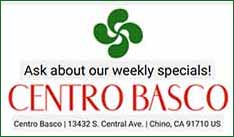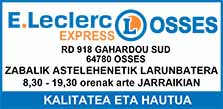Bill Dentzer. But what Idaho Basques lack in raw numbers, they more than make up in concentration, visibility and distinctiveness. Basques began arriving here more than a century ago, flourishing as they integrated themselves into civic and social life while preserving their unique heritage and cultural identity. Their strong and unique presence made Boise a natural pick for the first Jaialdi festival in 1987, and for those that have followed every five years since 1990.
“What we do have is a very concentrated, more recent immigration that is very visible and vocal,’’ says Gloria Totoricaguena (Toto-REE-ka-GWAY-na), a second-generation Boise Basque and scholar who did her Ph.D. dissertation on what is known as the Basque diaspora. She’s written seven books on Basques, including one specifically on Basques in Boise.
“When you have a state like Idaho that has a low population to start with, then any group of immigration makes a big splash,” she said. “What we have in the Treasure Valley is concentration, not population.”
Beginning in the early 1800s, Basques left their homeland in northern Spain to escape civil war, economic hardship and political oppression. Leaving Spain, they sought opportunity, a measure of acceptance and peace. They flocked to the Americas, initially to places like Argentina, Chile and Mexico, where their descendants today number in the millions. They began to filter into the U.S., as did other eager new arrivals, to chase the gold and silver strikes in the West. When they arrived, however, they saw greater opportunity in feeding and outfitting the miners than in digging for precious metals themselves.
Essentially stateless in their homeland, but with a culture and identity that predates even the Roman conquest of Europe, Basques readily assimilated here while still maintaining their strong cultural identity. To the extent that they encountered prejudice and discrimination, it was more for their religion – Catholicism – than for ethnicity.
Ben Ysursa, who retired as Idaho’s secretary of state this year after three terms and more than 40 years in the office overall, remembers the stories told by his predecessor, Pete Cenarrusa, a fellow Basque who held the office for 36 years. Among them: a young Cenarrusa growing up in Bellevue and whupping a schoolyard bully who picked on him for being Basque.
More important, said Ysursa, whose grandparents were first-generation arrivals here, was a strong sense of community among the Basques living here.
“Pete always thought the fact that Basques usually took care of their own problems internally, that the local communities had no problem having a celebration with Basques,” Ysursa said. “They respect the community and the mores of the community, and worked hard. The perception was that Basques will take care of themselves. You don’t have to worry about them.”
And indeed, Basques did take care of themselves – from the boarding houses where recent immigrants started new lives here and sheepherders found a respite from their isolated lives, to the Basque Mutual Aid societies that were formed to provide community assistance. Boise Basques created one in 1908.
“Basque society in the homeland is very much about you and your neighbor,” Totoricaguena said. “Civil rights or political rights are not given to an individual; they’re giving to a community, a town, to an area like a neighborhood, who you can see from your farmhouse. That value of we, us, our, is different from I, me, mine. Basque values are plural, and so that affects their integration into their community.”
Waves of Basque movement here crested in the early 1900s through the mid-1920s, when immigration laws were tightened, and again in the 1930s to the 1950s, amid the Spanish Civil War and a loosening of immigration restrictions driven by a need for workers. Basque immigration all but ended in the 1970s, with both economic opportunities and political conditions improving in Spain.
As the first-generation Basques started families here, or brought them over, they integrated easily.
“In order to be a good Basque, you’ve got to be a good American first,” Totoricaguena said. “You’ve got to participate, you’ve got to engage. You’ve got to know what’s happening around you, particularly in economic development.”
“You’ve got know how laws are made. You’ve got to understand how the society functions. Basques from the very beginning very much engage with elected officials – how does this work? What are the rules of the game? And learning the rules of the political game, the economic game, to make sure that they’ll be as successful as possible in their in the stay in the US – because a lot of them think they’re going to go home.”
But most did not, and they began to create the unique cultural institutions and social events out of which the idea for Jaialdi was born. In the 1930s, Treasure Valley Basques began gathering for the Christmastime “Sheepherder’s Ball,” held at a slow time of year for the herders, as well as summertime picnics. Ysursa, whose grandparents ran a boarding house called the Valencia on Idaho Street, remembers the picnics fondly.
The Boise Basque Center was inaugurated in 1949. The Oinkari dancers got their start in 1960. The Basque block on Grove Street, comprising restaurants, the Basque center and museum, the Jacobs-Uberuaga boarding house, and the 1914 Anduiza building with its indoor fronton, or Basque handball court, got its finishing touches in time for the 2005 Jaialdi.
And Jaialdi itself? It kicked off in 1987. The North American Basque Association meets annually in Elko, Nev. – in many ways, a smaller version of Boise’s festival, in terms of Basque presence and influence. But unlike that Nevada confab, Boise’s Jaialdi was envisioned from the start as an international event.
“One thing that is interesting about Boise is the leadership that we have had here,” Totoricaguena said. “Because it’s a small state, it’s easier to get access to the mayor’s office, it’s easy to get access to the secretary of state’s office, it’s easy to get access to the governor’s office....
“There were people in Boise who had experience with big Basque festivals. Let’s just declare this the Basque international festival. We’ll invite the Basque government officials , we’ll let all of those North America Basque organizations know, and let’s have it at the Old Pen (Old Idaho State Penitentiary).
“And so many people came and it was so much fun, let’s do it again.”
To Basques and non-Basques alike, then, “Ongi etorri!”
Where Idaho’s Basques live Top 10 Counties
- Ada 3,308 Canyon 1,139
- Twin Falls 701
- Gooding 357
- Kootenai 345
- Bannock 311
- Owyhee 224
- Elmore 175
- Gem 173
- Payette 166
- All others: 1,007
- Total: 7,906
Top 10 cities
- Boise 2,041
- Meridian 549
- Twin Falls 536
- Nampa 440
- Caldwell 281
- Pocatello 236
- Hayden 171
- Gooding 145
- Mountain Home 117
- Idaho Falls 102
Basques by the numbers
- Total United States residents of Basque descent (2013 estimate): 56,673
Top 10 states
- California 18,413
- Idaho 7,906
- Nevada 5,092
- Oregon 2,626
- Washington 2,271
- Texas 2,140
- Arizona 2,019
- Colorado 1,925
- Florida 1,642
- New York 1,451
- Other states/territories: 11,260
Idaho Basques: Myths and misconceptions
1. Idaho (or Boise) has the largest concentration of Basques outside of the Basque region of Spain/France.
Not even close. Idaho doesn’t even have the most Basques in the U.S. California does, with about 18,000, according to 2013 census estimates.
2, Most Idaho Basques came here from Spain.
Most Basques who came to Idaho in the late 1800s and early 1900s had previously immigrated to the United States, Mexico or South America and were relocating here. Basques who arrived later, from the 1930s on, mostly came from Bizkaia , and within that region, from a small triangle between Bakio and Ondarroa on the coast and inland to Durango.
3. Basques came here to be sheepherders.
Basques relocated to Idaho after the discovery of gold and silver. Rather than mine the metals, they became ranchers or farmers to feed the miners.
4. Basques were drawn to sheepherding because that’s what they did in the Basque Country.
Like most immigrant groups, Basques took low-level jobs that no one else wanted. Also, sheepherding required little upfront investment, because sheep could be raised and tended on public land, and English was not required. Basques who immigrated to Argentina in the 1820s developed ranching and herding skills there, not in the Basque Country.
5. Paella is a Basque dish.
Paella, a pan-cooked dish of rice, vegetables and various meats or seafood, originated in Valencia, on Spain’s eastern coast. The Basque variety contains chicken, chorizo and seafood.



 Enviar a un amigo
Enviar a un amigo Añadir comentario
Añadir comentario








